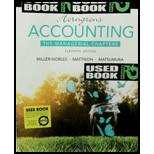
Horngren's Accounting
11th Edition
ISBN: 9780133851151
Author: MILLER-NOBLES, Tracie L., Mattison, Brenda., Matsumura, Ella Mae, Horngren, Charles T.
Publisher: Pearson,
expand_more
expand_more
format_list_bulleted
Question
Chapter 17, Problem P17.1CP
To determine
Introduction:
Analysis of Financial Statements
- Analysis of Financial Statements is a study of several key metrics of a company based on the data presented in its’ financial statements with an objective to evaluate the financial health of a company.
- It is essential for investors, stakeholders, government bodies etc. to evaluate the key metrics of an entity in order to ensure that the company fulfills the going concern principle and displays financial stability.
Trend Analysis
- Trend Analysis is a technique of performance measurement and evaluation where the performance of the current year is compared to that of a base year and the direction of the results are analyzed.
- The movement of the results can be interpreted as a positive or favorable trend or as a negative or unfavorable trend.
- Favorable trends mean increase in revenues and decrease in costs and are hence subjective in nature. Unfavorable trends mean decrease in revenues and increase in costs and are also subjective in nature.
- Trend analysis helps in evaluation of repetitive behavior as well as evaluation of effectiveness of strategies implemented by allowing analysis of performance over time.
Whether investment can be made in the company.
Expert Solution & Answer
Want to see the full answer?
Check out a sample textbook solution
Students have asked these similar questions
General accounting and question
Can you help me solve this financial accounting question ?
Can you help me solve this general accounting problem with the correct methodology?
Chapter 17 Solutions
Horngren's Accounting
Ch. 17 - Prob. 1QCCh. 17 - Prob. 2QCCh. 17 - Prob. 3QCCh. 17 - Prob. 4QCCh. 17 - Prob. 5QCCh. 17 - Prob. 6QCCh. 17 - Prob. 7QCCh. 17 - Prob. 8QCCh. 17 - Prob. 9QCCh. 17 - Prob. 10QC
Ch. 17 - Prob. 1RQCh. 17 - Prob. 2RQCh. 17 - Prob. 3RQCh. 17 - Prob. 4RQCh. 17 - Prob. 5RQCh. 17 - Prob. 6RQCh. 17 - What is benchmarking, and what are the two main...Ch. 17 - Prob. 8RQCh. 17 - Prob. 9RQCh. 17 - Prob. 10RQCh. 17 - Prob. 11RQCh. 17 - Prob. 12RQCh. 17 - Prob. 13RQCh. 17 - Prob. 14ARQCh. 17 - Prob. 15ARQCh. 17 - Prob. S17.1SECh. 17 - Prob. S17.2SECh. 17 - Prob. S17.3SECh. 17 - Performing vertical analysis Hoosier Optical...Ch. 17 - Prob. S17.5SECh. 17 - Prob. S17.6SECh. 17 - Use the following information for Short Exercises...Ch. 17 - Prob. S17.8SECh. 17 - Prob. S17.9SECh. 17 - Prob. S17.10SECh. 17 - Prob. S17.11SECh. 17 - Prob. S17.12SECh. 17 - Prob. S17.13SECh. 17 - Prob. S17.14SECh. 17 - Performing horizontal analysisincome statement...Ch. 17 - Prob. E17.16ECh. 17 - Prob. E17.17ECh. 17 - Prob. E17.18ECh. 17 - Prob. E17.19ECh. 17 - Prob. E17.20ECh. 17 - Prob. E17.21ECh. 17 - Prob. E17.22ECh. 17 - Prob. E17.23ECh. 17 - Prob. E17.24ECh. 17 - Prob. E17.25ECh. 17 - Prob. E17.26ECh. 17 - Prob. P17.27APGACh. 17 - Prob. P17.28APGACh. 17 - Prob. P17.29APGACh. 17 - Prob. P17.30APGACh. 17 - P17-31A Using ratios to evaluate a stock...Ch. 17 - Prob. P17.32APGACh. 17 - Prob. P17.33APGACh. 17 - Prob. P17.34BPGBCh. 17 - Prob. P17.35BPGBCh. 17 - Prob. P17.36BPGBCh. 17 - Prob. P17.37BPGBCh. 17 - Prob. P17.38BPGBCh. 17 - Prob. P17.39BPGBCh. 17 - Prob. P17A.40BPGBCh. 17 - Prob. P17.41CPCh. 17 - Prob. P17.1CPCh. 17 - Prob. 17.1DCCh. 17 - Prob. 17.1EICh. 17 - Prob. 17.1FSC
Knowledge Booster
Similar questions
- Please explain the correct approach for solving this general accounting question.arrow_forwardUnion National Bank has an issue of preferred stock with a $6.20 stated dividend that just sold for $105 per share. What is the bank’s cost of preferred stock? Financial accounting problemarrow_forwardI need assistance with this general accounting question using appropriate principles.arrow_forward
- give me solution plzarrow_forwardWhat is the amount of total assets?arrow_forwardA man earned wages of $52,800, received $1,600 in interest from a savings account, and contributed $4,200 to a tax-deferred retirement plan. He was entitled to a personal exemption of $3,700 and had deductions totaling $5,400. Find his gross income, adjusted gross income, and taxable income. Accurate answerarrow_forward
arrow_back_ios
SEE MORE QUESTIONS
arrow_forward_ios
Recommended textbooks for you

 AccountingAccountingISBN:9781337272094Author:WARREN, Carl S., Reeve, James M., Duchac, Jonathan E.Publisher:Cengage Learning,
AccountingAccountingISBN:9781337272094Author:WARREN, Carl S., Reeve, James M., Duchac, Jonathan E.Publisher:Cengage Learning, Accounting Information SystemsAccountingISBN:9781337619202Author:Hall, James A.Publisher:Cengage Learning,
Accounting Information SystemsAccountingISBN:9781337619202Author:Hall, James A.Publisher:Cengage Learning, Horngren's Cost Accounting: A Managerial Emphasis...AccountingISBN:9780134475585Author:Srikant M. Datar, Madhav V. RajanPublisher:PEARSON
Horngren's Cost Accounting: A Managerial Emphasis...AccountingISBN:9780134475585Author:Srikant M. Datar, Madhav V. RajanPublisher:PEARSON Intermediate AccountingAccountingISBN:9781259722660Author:J. David Spiceland, Mark W. Nelson, Wayne M ThomasPublisher:McGraw-Hill Education
Intermediate AccountingAccountingISBN:9781259722660Author:J. David Spiceland, Mark W. Nelson, Wayne M ThomasPublisher:McGraw-Hill Education Financial and Managerial AccountingAccountingISBN:9781259726705Author:John J Wild, Ken W. Shaw, Barbara Chiappetta Fundamental Accounting PrinciplesPublisher:McGraw-Hill Education
Financial and Managerial AccountingAccountingISBN:9781259726705Author:John J Wild, Ken W. Shaw, Barbara Chiappetta Fundamental Accounting PrinciplesPublisher:McGraw-Hill Education


Accounting
Accounting
ISBN:9781337272094
Author:WARREN, Carl S., Reeve, James M., Duchac, Jonathan E.
Publisher:Cengage Learning,

Accounting Information Systems
Accounting
ISBN:9781337619202
Author:Hall, James A.
Publisher:Cengage Learning,

Horngren's Cost Accounting: A Managerial Emphasis...
Accounting
ISBN:9780134475585
Author:Srikant M. Datar, Madhav V. Rajan
Publisher:PEARSON

Intermediate Accounting
Accounting
ISBN:9781259722660
Author:J. David Spiceland, Mark W. Nelson, Wayne M Thomas
Publisher:McGraw-Hill Education

Financial and Managerial Accounting
Accounting
ISBN:9781259726705
Author:John J Wild, Ken W. Shaw, Barbara Chiappetta Fundamental Accounting Principles
Publisher:McGraw-Hill Education